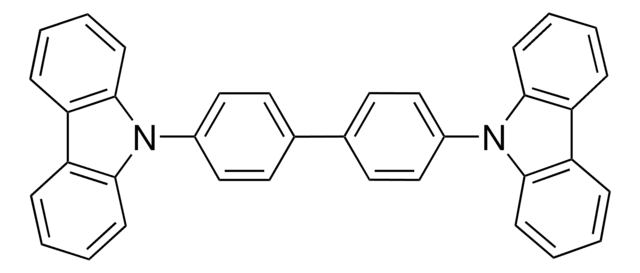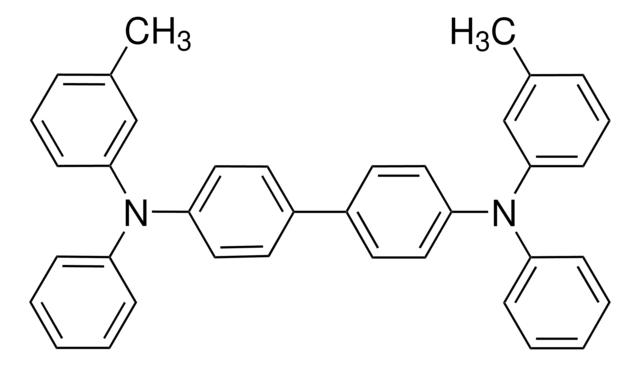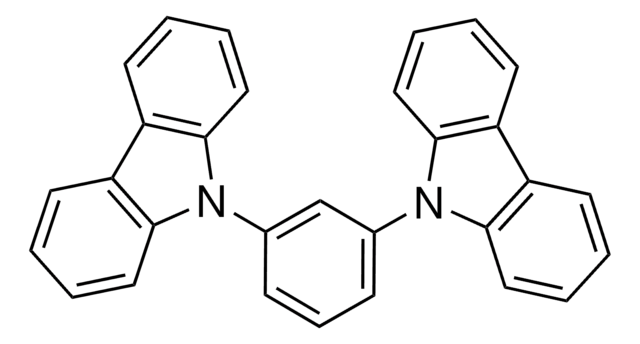Key Documents
699195
4,4′-Bis(N-carbazolyl)-1,1′-biphenyl
sublimed grade, 99.9% trace metals basis
Synonim(y):
4,4′-Bis(9-carbazolyl)-1,1′-biphenyl, 4,4-N,N′-Dicarbazole-1,1′-biphenyl, CBP, DCBP
About This Item
Polecane produkty
klasa czystości
sublimed grade
Poziom jakości
Próba
99.9% trace metals basis
Postać
solid
charakterystyka ekologicznej alternatywy
Design for Energy Efficiency
Learn more about the Principles of Green Chemistry.
sustainability
Greener Alternative Product
strata
0.5 wt. % loss on heating, 279.6 °C (typical, TGA)
mp
277.9 °C (typical, DSC)
281-285 °C
λmaks.
532 nm
Energia orbitalna
HOMO 6 eV
LUMO 2.9 eV
Wydajność urządzenia OLED
ITO/HMPD/CBP:Ir(ppy)3 (6%)/Alq3/Mg:Ag
ITO/MoO3/CBP/CBP:Ir(ppy)2(acac) (6%)/TPBI/LiF/Al
ITO/NPD/CBP:Ir(ppy)3 (6%)/Alq3/Mg:Ag
ITO/NPD/CBP:Ir(ppy)3 (6%)/niBr/Alq3/Mg:Ag
ITO/NPD/CBP:Ir(ppy)3/BCP/Alq3/Mg:Al
ITO/PEDOT:PSS/NPD/CBP:Ir(piq)3 (6 wt%)/Alq3/LiF/Al
ITO/TAPC/CBP:FIrpic (6%)/PO14/LiF/Al
kategoria ekologicznej alternatywy
ciąg SMILES
c1ccc2c(c1)n(-c3ccc(cc3)-c4ccc(cc4)-n5c6ccccc6c7ccccc57)c8ccccc28
InChI
1S/C36H24N2/c1-5-13-33-29(9-1)30-10-2-6-14-34(30)37(33)27-21-17-25(18-22-27)26-19-23-28(24-20-26)38-35-15-7-3-11-31(35)32-12-4-8-16-36(32)38/h1-24H
Klucz InChI
VFUDMQLBKNMONU-UHFFFAOYSA-N
Szukasz podobnych produktów? Odwiedź Przewodnik dotyczący porównywania produktów
Opis ogólny
Hasło ostrzegawcze
Danger
Zwroty wskazujące rodzaj zagrożenia
Zwroty wskazujące środki ostrożności
Klasyfikacja zagrożeń
Eye Dam. 1 - Skin Irrit. 2 - STOT SE 3
Organy docelowe
Respiratory system
Kod klasy składowania
11 - Combustible Solids
Klasa zagrożenia wodnego (WGK)
WGK 3
Temperatura zapłonu (°F)
Not applicable
Temperatura zapłonu (°C)
Not applicable
Środki ochrony indywidualnej
dust mask type N95 (US), Eyeshields, Gloves
Wybierz jedną z najnowszych wersji:
Masz już ten produkt?
Dokumenty związane z niedawno zakupionymi produktami zostały zamieszczone w Bibliotece dokumentów.
Klienci oglądali również te produkty
Produkty
Plexcore® organic conductive inks are electronic grade inks formulated for use in the hole injection layers of OLEDs.
Sublimed materials for organic electronic devices such of OFETs and OTFTs allow the achievement of better electronic properties, and may help increase a device’s lifetime.
Organic Semiconductor Laser Materials
Pochodne bis-styrylobenzenu mają obiecujące właściwości w zakresie niskich progów laserowania. Omówiono rozważania projektowe dotyczące cząsteczek emitujących światło organiczne.
Nasz zespół naukowców ma doświadczenie we wszystkich obszarach badań, w tym w naukach przyrodniczych, materiałoznawstwie, syntezie chemicznej, chromatografii, analityce i wielu innych dziedzinach.
Skontaktuj się z zespołem ds. pomocy technicznej









